Bitcoin Guide
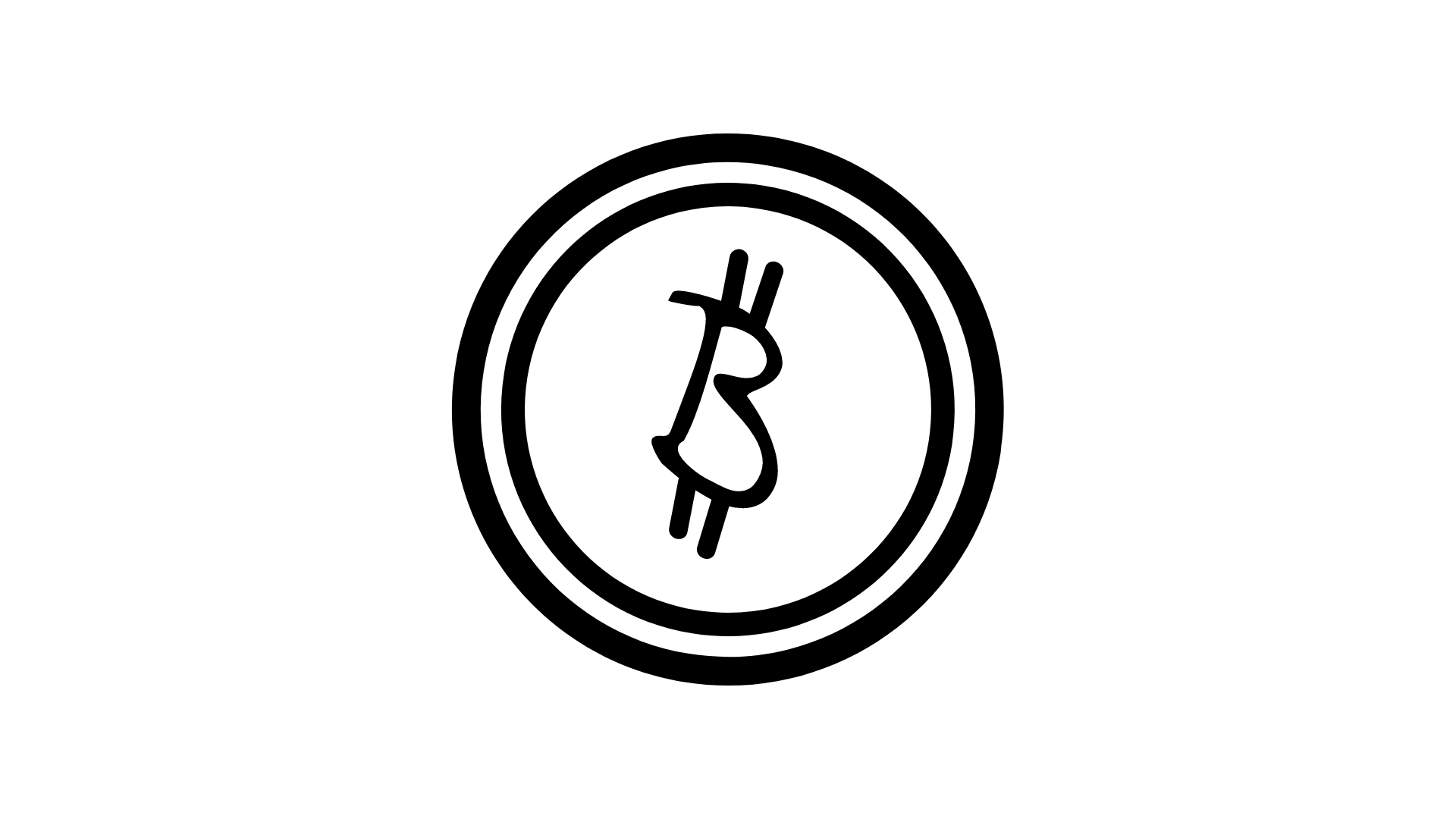
This guide was created with the sole purpose to bring a beginners-level knowledge and understanding of the Bitcoin blockchain, bitcoin as a decentralized currency, and the evergreen question “What is Bitcoin?”.
All protagonists in the guide are unreal!
Note: Bitcoin is used as a reference to the technology & bitcoin is used as a reference to the currency.
Table of content:
Bitcoin History
When was Bitcoin created?
The idea behind bitcoin was introduced to the world on Oct. 31, 2008, at the depth of the financial crisis by a pseudonymous person called Satoshi Nakamoto. Nakamoto posted a message on a cryptography mailing list titled, “Bitcoin P2P e-cash paper.” It contained a link to a whitepaper called “Bitcoin: A Peer-to-Peer Electronic Cash System.”, which to this day is still available online.
In those 9 pages, Nakamoto laid out the concept of Bitcoin as a decentralized, digital currency that promised the ability to conduct government-free transactions, relying on proof of work, digital signatures, and digital coins instead of centrally minted government-issued currency.
All transactions are meant to be kept on a ledger that is publicly accessed by anyone, ensuring transparency. On Jan. 3, 2009, the blockchain was launched when the first block, called – “the genesis block”, was mined. The first test transaction took place about one week later and for the first few months of its existence, it was obtainable only by miners validating the bitcoin blockchain.
At that point, Bitcoin had no real monetary value. Miners solved complex math problems to uncover new bitcoins and verify previous bitcoin transactions traded bitcoin back and forth just for fun. It would take more than a year for the first economic transaction to take place, when a Florida man negotiated to have two Papa John’s pizzas, valued at $25, delivered for 10,000 bitcoins on May 22, 2010. That transaction essentially established the initial real-world price or value of Bitcoin at 4 bitcoins per penny.
Who is Satoshi Nakamoto?
Satoshi Nakamoto is the anonymous name used by the creators of the bitcoin cryptocurrency.
The actual person that the name represents has never been identified, leading many people to believe that it is a pseudonym for a person or a group of people.
The persona Satoshi Nakamoto was involved in the early days of Bitcoin, working on the first version of the software back in 2009. His/their involvement with Bitcoin, however, ended in 2010.
The last correspondence anyone had with him/them was in an email to another cryptocurrency developer saying that they had “moved on to other things.”
The inability to put a face to the name has led to significant speculation as to Satoshi’s identity, especially as cryptocurrencies increased in number, popularity, and notoriety.
While the identity of Nakamoto has not been ascribed to a provable person, it is estimated that the value of bitcoins under Nakamoto’s control is about 1 million in number. Given that the maximum possible number of bitcoins generated is 21 million, Nakamoto’s stake of 5% of the total bitcoin holdings has considerable market power.
Several people have been put forward as the “real” persona, though none have been proven.
Bitcoin Tech Explained
What is Bitcoin?
Bitcoin is a new kind of global payment network. Like MasterCard or PayPal, it allows money to be transmitted electronically. But Bitcoin is different from these conventional payment networks in some important ways:
- First, the Bitcoin network is decentralized. The MasterCard or PayPal networks are owned and operated by centralized entities. But there is no Bitcoin Inc. Instead, thousands of computers around the world called nodes, process Bitcoin transactions in a peer-to-peer fashion. No company, country, or third party is in control of it; and anyone can become part of it.;
- Second, MasterCard and PayPal payments are based on conventional currencies such as the US dollar. In contrast, the Bitcoin network has its unit of account – bitcoin. The value of one bitcoin fluctuates against other currencies in the same way the euro’s value fluctuates against the dollar.;
- Every transaction involving Bitcoin is tracked on the blockchain. In simple terms, it can be explained as an Excel spreadsheet that is saved on thousands of different hard drives, all of which reference each other to validate the data’s accuracy.;
- There will only ever be 21 million bitcoins. This is digital money that cannot be inflated or manipulated in any way.;
- It isn’t necessary to possess an entire bitcoin: you can possess just a fraction of it if that’s all you want, need, or can afford. 🙂
How does Bitcoin work?
After answering the evergreen question, “What is Bitcoin?” it is time to dive into how Bitcoin actually works.
The core of the Bitcoin network is a shared, public record of Bitcoin transactions known as the blockchain. Every Bitcoin transaction that has ever occurred is listed in the blockchain, and every full node (computer) in the Bitcoin network has a copy of it.
Transferring bitcoin funds from one user to another begins with the submission of a transaction to the bitcoin network. This can be done on your computer or via a mobile app. Nodes – other computers on the blockchain network – verify the transaction details. Once bitcoin transactions are transmitted to the network, they are first verified by available Bitcoin nodes. In short, miners are verifying that the sender truly owns the bitcoin that they are trying to send. To incentivize Bitcoin miners to verify their transactions first out of all pending transactions in the mempool, users attach transaction fees — rewards that miners will receive in addition to the programmed mining subsidy if they successfully verify the transaction and add it to a block on the Bitcoin blockchain. Once that verification is complete, the transaction sits in the node’s unconfirmed transactions waiting area, also known as “mempool.”
Miners take these pending transactions and combine them to create a “block,” which they then compete to verify by racing to solve a computational mathematical problem – the so-called Proof of Work.
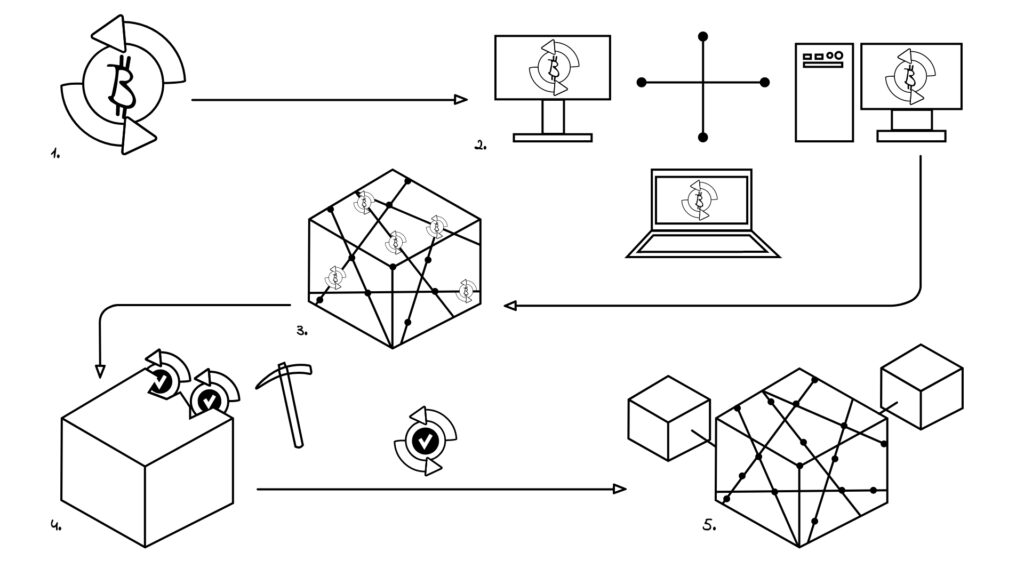
How do Bitcoin transactions work?
The actual structure of Each Bitcoin transaction consists of three main parts:
- input -The bitcoin address from which the sender wants to send bitcoin and from which he previously received bitcoin.;
- amount – The amount of bitcoin the sender wants to send to the recipient.;
- output – Recipient’s bitcoin address. Bitcoin addresses are 34-character long strings of letters and numbers and are also known as “public key”. It contains the address to which the transfer is made and the amount shipped. Each public key has its own corresponding private key—a string of letters and numbers that is used to “sign” transactions.
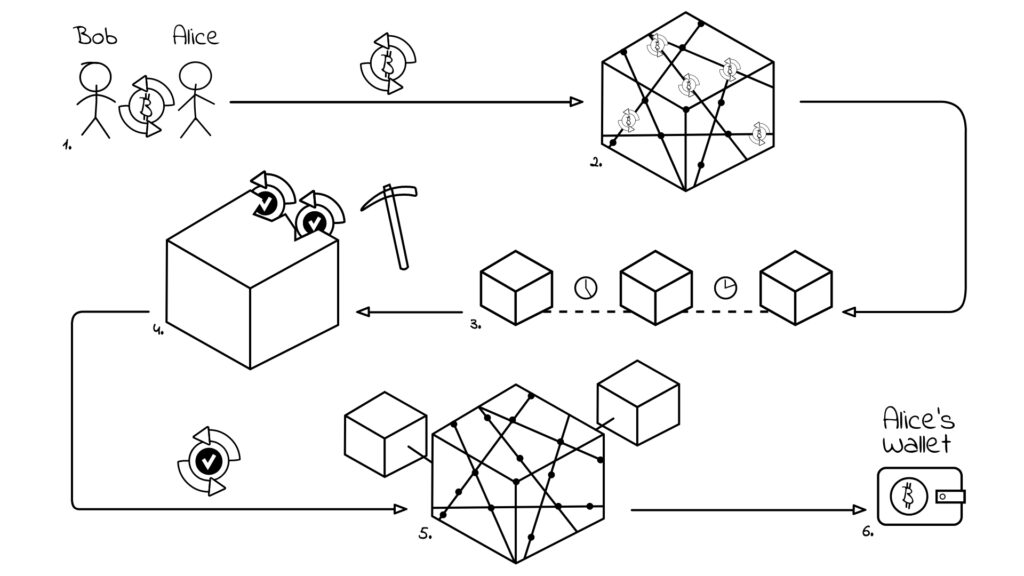
Short example:
Bob’s bitcoin wallet address has received a total of 5 bitcoin over the course of a certain period of time (lucky him), and he wants to send 2 BTC to Carol (it’s good to have friends). 🙂
The bitcoin transaction will have one input (the unspent outputs of the bitcoin transaction through which he received those 5 BTC) and create two different outputs when he sends BTC to Carol. The first output will be the transaction to Carol, for the full amount of 2 BTC.
The second output will be the “change” transaction, which “returns” the unspent 3 BTC to Bob’s wallet address. To send Carol those 2 bitcoins, first, Bob has to submit his intention on the network. After inputting all the transaction details, he inputs his private key into the Bitcoin software to “sign” the transaction, which gives the green light to send the bitcoins.
At this point, the transaction is up for validation by the network.
The network first checks if the signature produced by the private key matches its corresponding public key. If it matches, the miners will then check if Bob has enough BTC to send or if he already sent it to someone else. If everything is OK – the transaction is validated. A Bitcoin transaction must be confirmed on the blockchain to verify that the transaction is legitimate. A confirmed transaction means that the transaction has been included in a block, and therefore included in the blockchain. That means the transaction has now been officially recorded and verified.
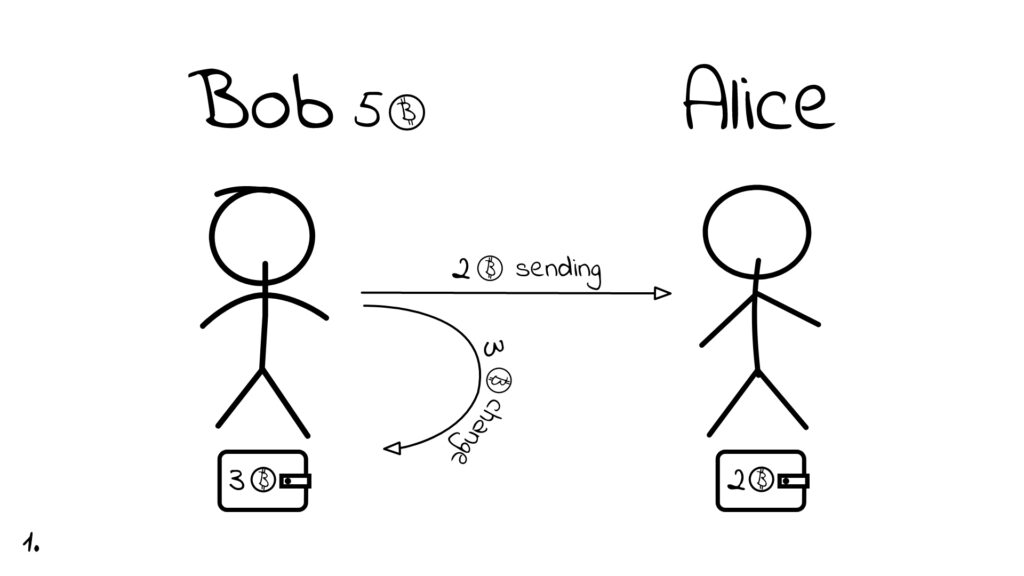
How do people get Bitcoins?
New bitcoins are created through a process called – mining. But as the Bitcoin network has grown, mining has become too technologically complex to be practical for new users to get bitcoins. So for most people, the better way to get Bitcoins is to purchase them from others who already have them. There are several ways to do this. There are bitcoin exchanges, user-friendly services that will sell bitcoins to customers at the current exchange rate and lately, bitcoin ATMs, which buy and sell bitcoins for cash. There are three main ways people can get Bitcoins. You can buy bitcoins using alternative or fiat currencies such as cash.
- You can sell things or services you produce and let people pay you with bitcoins.
- Or they can be created using a mining computer.
NOTE: The easiest way to get bitcoin is not to mine it, but to buy it or accept it as payment for your time/work/service, or product.
What is Bitcoin Mining?
Bitcoin mining is the process that adds new Bitcoin transactions to the distributed ledger known as the blockchain. Mining is also how new coins come into existence as a reward for being the first miner to add the next block of transactions to the blockchain.
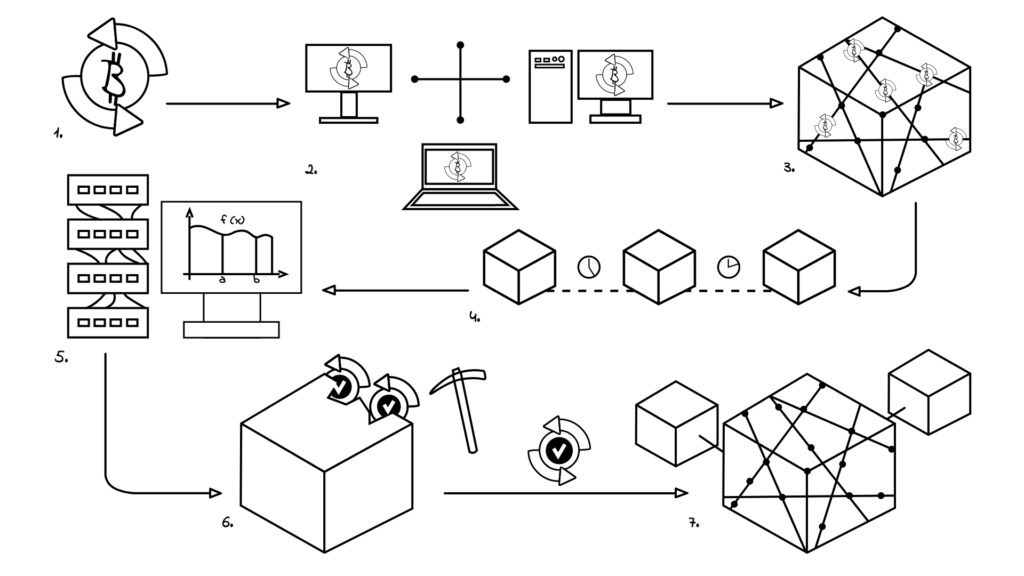
The transactions in the network are confirmed by Bitcoin miners, who use special computer hardware to do the such as the Bitcoin network. Bitcoin miners are rewarded for this service with transaction fees and newly generated bitcoins (+ the satisfaction of knowing they are helping to create, validate, and protect the Bitcoin network).
What is Proof-of-Work?
Decentralized cryptocurrency networks such as the Bitcoin network need to make sure that nobody spends the same money twice without a central authority in the middle. To accomplish this, networks use something called a – consensus mechanism – which is a system that allows all the computers in a peer-to-peer network to agree on which transactions are legitimate.
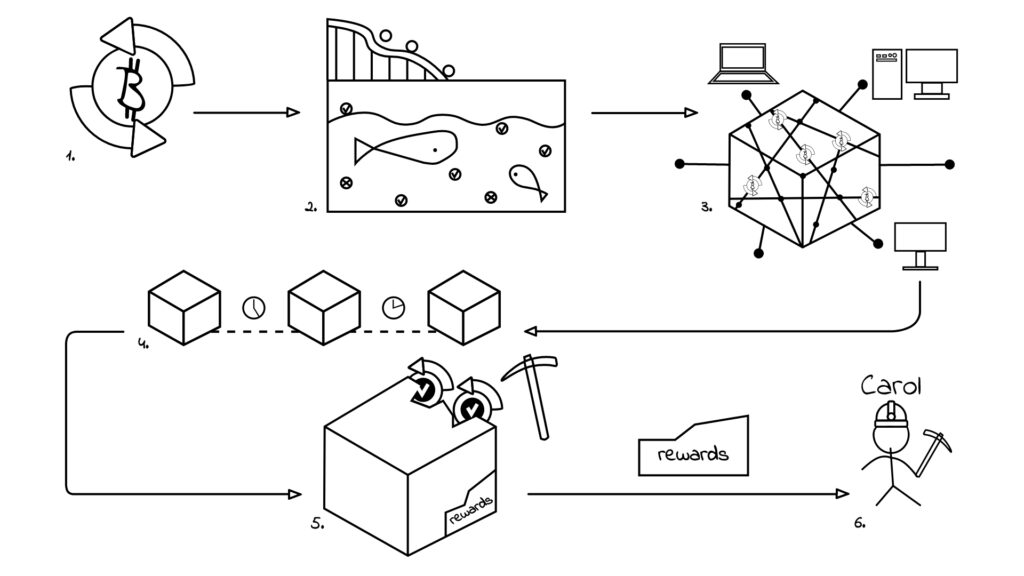
Proof-of-Work is a mechanism that Bitcoin uses to reach a consensus on the blockchain. In the proof-of-work bitcoin blockchain, the right to add new blocks to the blockchain is given to the participants that are ready to spend computational power to solve cryptographic problems. Participants competing to add new blocks are called “miners”, and the process itself – “mining”. When a new piece of information (like a transaction) needs to be added to the blockchain, the miners engage their computational powers to validate it on the blockchain.
This is done by finding a “hash” that satisfies a particular condition set by the network’s protocol. A hash is the result of a hash function often used in cryptography. It maps data of any format and size to fixed-sized values. In the case of Bitcoin, the hash function used is SHA-256. In creating new blocks, miners hash three things:
- the hash of the previous block;
- the set of transactions to be added to the blockchain;
- a nonce (without it the resulting hash would always be the same as the blockchain data is invariable) until the hash that satisfies the requirement for a valid proof of work is found.
The protocol sets a level of mining difficulty which is algorithmically adapted in a way that the time to find a correct hash (hence a new block) averages out to ten minutes. Mining is competitive, and the participant who finds the required hash the fastest is rewarded with some amount of bitcoin. The level of reward is set by the blockchain protocol, and since the latest halving in May 2020, equals 6.25 BTC per block.
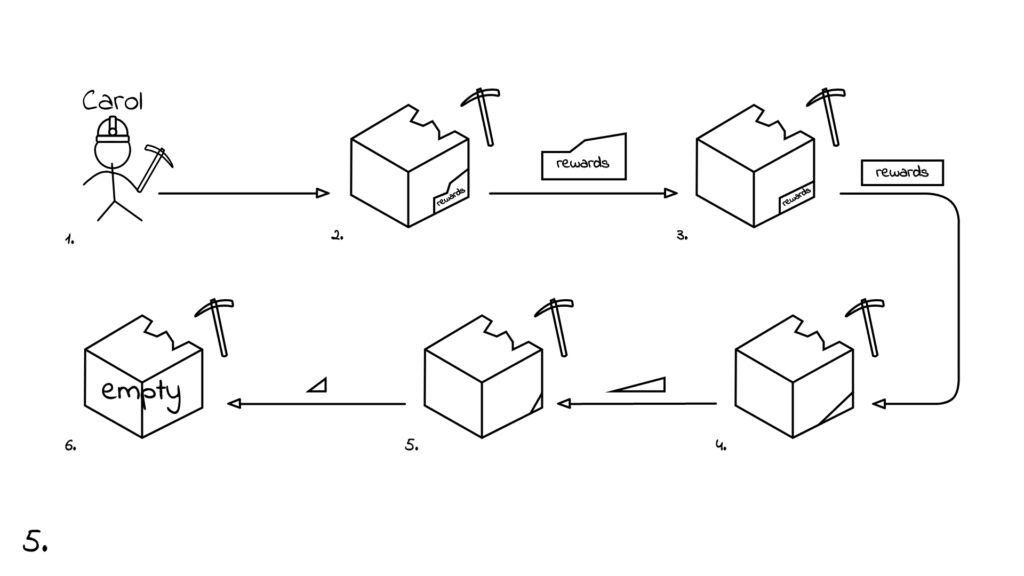
In some cases, miners can find more than one block that satisfies the requirements of the protocol at the same time, which splits the chain end into two. Since there can only be one canonical chain, the protocol needs a way of handling such situations. In Bitcoin, only the longest chain is viewed as the correct chain: Miners will continue to mine on both chains initially, but as soon as another block is found on top of one of the two previous blocks, that chain will become the canonical chain and miners are economically incentivized to discard the other block.
How does the Lightning Network work?
The Lightning Network is a decentralized network that uses smart contract functionality in the Bitcoin blockchain to facilitate instant micropayments across a network of users without hefty fees or long confirmation times. It’s considered an off-chain or Layer-2 solution because it involves activity that doesn’t occur directly on the blockchain. First, users must establish their own multi-signature Lightning wallet, and the two parties involved exchange a single key to validate their spending transactions.
In this way, the transactions are kept from being broadcast on the main Bitcoin blockchain while also being verifiable and accurate. This off-chain (Layer 2) transactions occur independently of on-chain (Layer 1 or the so-called “Layer 1 Crypto“) transactions and do not have to be updated on the main blockchain unless the two parties open or close a channel. Many Lightning Network transactions can occur before their record is broadcast to the blockchain.
Once the two participants decide to close the transaction channel, all of the channel’s information is then consolidated into one transaction, which is sent to the Bitcoin main net for settlement. The goal is not to spam the main blockchain with dozens of small transactions, but rather to simplify them into one transaction that takes less time and effort for the nodes to validate. Last but not least, it makes bitcoin fees significantly lower.
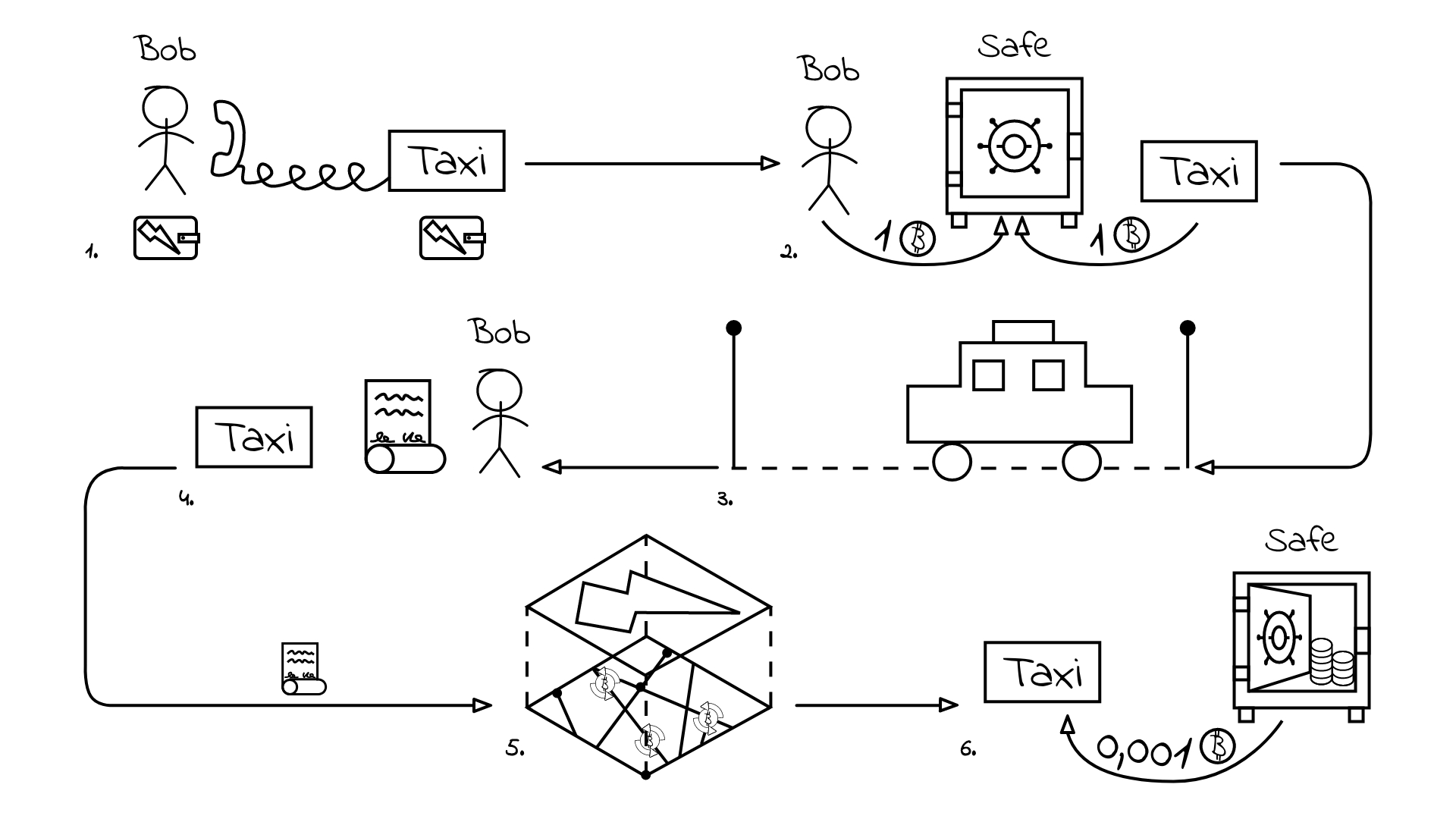
Bitcoin as an Investment
Why is Bitcoin so valuable?
Bitcoin has value due to the same reason paper and digital cash do – it’s a handy form of money commonly accepted by people. It is used to transfer value and buy or sell things and services. Yet, unlike the US dollar, whose value and legal status are enforced by the government, Bitcoin’s value comes from – code, infrastructure, scarcity, and adoption.
Bitcoin’s code gives features of scarcity, divisibility, portability, fungibility, and recognizability. Moreover, Bitcoin is decentralized and can be used without middlemen, provides some level of transparency, and can be accessed and used by anyone with an internet connection.
Most importantly, it can be used as a store of value like gold or other commodities, yet unlike its physical counterparts, it can be transported from one end of the world to the other via communication channels in a matter of minutes.
Bitcoin’s valuable properties come from:
Bitcoin scarcity. Unlike traditional fiat currencies that can be inflated/printed without end, Bitcoin introduces digital scarcity. There are going to be only 21 million BTC. ;
Divisibility. A single Bitcoin can be divided into 100000000 satoshi (or sats). One “satoshi” equals 0.00000001 BTC, the smallest unit of Bitcoin at the moment. This level of division is embedded in Bitcoin’s original code. If there’s ever a need, the level of division can be changed into 16 or more decimal places, meaning that Bitcoin offers an infinite degree of divisibility.;
Portability. Bitcoins can be transferred through a communication channel like the internet, satellites or even radio waves, which makes it the most transferable currency that exists today or ever existed.; Fungibility. Every Bitcoin has the same value as its counterpart, regardless of who owns it and what history it has. Just like one ounce of pure gold is always equal to another ounce of pure gold. One Bitcoin remains a symbol of value interchangeable with another Bitcoin.;
Recognizability. A growing number of merchants and users recognize and accept Bitcoin. Although it’s still far from the level of acceptance and adoption of fiat currencies, many people and businesses distinguish Bitcoin from non-currencies or other counterfeit money and are willing to accept it as a means of payment.; Decentralization. No single entity oversees Bitcoin. Unlike traditional money, no one can censor, control, or change the network or its transactions.;
Accessibility. You don’t need to have a bank account to own or accept Bitcoins. All you need is some basic computer knowledge and an internet connection. Bitcoin’s accessibility makes it extremely convenient for unbanked areas of the world.;
Uncounterfeitability. Every Bitcoin transaction is recorded on a distributed ledger and is secured by the computation work of nodes all around the world. The system was designed to prevent the double-spend problem which hindered preceding digital currencies from taking off. As a result, all transactions on the Bitcoin network are uncounterfeitable.
What happens to Bitcoin after all 21 million are mined?
When Bitcoin was created back in 2009, it was set up with certain protocols and rules. One of the more significant rules was that there would be a 21 million coin cap on the amount of Bitcoin that would go into circulation. Currently, there are approximately 18.8 million Bitcoins in circulation, with an estimation of millions being lost and will never be brought back.
After all the bitcoins are mined (around the year 2140), there won’t be more coins available to mine. The only way there can be more bitcoins to mine is if the cryptocurrency’s protocol is changed to allow for an additional supply. Once all bitcoins are mined, those who engage in the mining process won’t receive block rewards because there will not be additional coins to be mined. Miners are only going to receive rewards for the transaction fees collected from every verified transaction. In addition, given that there are only about 2.2 million bitcoins that are yet to be mined, the cryptocurrency’s supply will be little and that could ultimately cause a huge spike in price.
Bitcoin & Security
How is Bitcoin secure?
Bitcoin technology is safe because it’s built on secure technology: the blockchain, which is public, decentralized, and permissionless. Here are the three main reasons why Bitcoin tech is safe:
- Bitcoin uses secure cryptography Compared to other financial solutions, the blockchain is an improved technology that relies on secure core concepts and cryptography. Blockchain uses volunteers — computers — to sign hashes that validate transactions on the bitcoin network using cryptography. This system makes it so transactions are generally irreversible, and the data security of bitcoin is strong.
- Bitcoin is public While being public may not sound safer, Bitcoin’s ledger transparency means that all the transactions are available to the public even if the people involved are anonymous. That makes it very difficult to cheat or scam the system.
- Bitcoin is decentralized Bitcoin’s distributed network has over ten thousand nodes all over the world that keep track of all transactions happening on the system. This large number of nodes ensures that if something happens to one of the servers or nodes, others can pick up the slack. It also means that trying to hack into one of the servers is pointless. There’s nothing there you could steal that the other nodes and servers couldn’t prevent unless you happen to control 51% of the nodes — not impossible, but extremely unlikely.
How to operate safely with bitcoins?
The best way to keep your bitcoins safe is to have your private key stored in a device that isn’t connected to the internet, or in a non-digital form. Ultimately, private keys can be shown in many different formats. Their most common form used to be a long string of random numbers and characters, which wasn’t particularly user-friendly.
Most of today’s crypto wallets won’t give you a cryptic private key by default anymore. Instead, the private key will be translated into seed words (seed phrase, mnemonic phrase, mnemonic, mnemonic seed, mnemonic seed phrase, seed key, or recovery phrase).
Depending on the wallet, you will be given either 12, 18 or 24 seed words (a secret phrase). These seed words make up your private key and are just another way of displaying in a human-readable way what could be shown as a painfully long string of random numbers and characters. In order to secure the funds associated with the seed words, one has to be memorized or written down in the exact order that they were given. Keeping a secret phrase private and ensuring that it won’t be lost is critical, as it is the only way to access and recover a wallet and all of its content.
Remember – Not your keys, not your coins!
How and where do I store my bitcoins?
Just as we keep cash or cards in a physical wallet, bitcoins are also stored in a wallet — a digital one. The digital wallets can be of two types:
- Hot wallets – A hot wallet is any wallet that is connected somehow to the Internet. The main purpose of holding cryptocurrency in a hot wallet is to facilitate basic transactions. Individuals looking to actually make purchases with their cryptocurrency assets might consider choosing a hot wallet. They are the ideal option for storing small amounts of bitcoin and other cryptocurrencies and are a fast way of spending and receiving payments.
- Cold wallets – Cold wallets have no connection to the Internet. Instead, they use physical gadgets to store the keys offline, making them resistant to online hacking attempts. As such, cold wallets tend to be a much safer alternative to “storing” coins. This method is also known as cold storage and is particularly suitable for long-term investors.
Wallets come in many forms in a matter of how they can be stored. Generally, wallets are divided into three main groups – Software wallets, Hardware wallets, and Paper wallets.
Bitcoin security issues
- Bitcoin isn’t anonymous While Bitcoin does disguise your personal information, it doesn’t disguise the address of your crypto wallet. That means you’re not “anonymous” but “pseudonymous” — and someone could use clues to track down your personal information. Governments can subpoena information, and cybercriminals use all kinds of illegitimate ways to obtain information. Because all the ledgers are public, if someone knew how much you spent, when, and where you spent it, they could find your transaction on the ledger and trace it back to your wallet. Once they’ve done that, they could map your spending habits, gather data on your life, and maybe even blackmail you.
- Bitcoin is volatile Although Bitcoin uses secure cryptography, you could argue it’s not a safe investment because of its volatility. With no regulatory body, a bitcoin worth $60,000 one day can be worth $30,000 just a few days later. Though there have been some periods of stability, these never last long. After all, there’s a reason why people joke that Bitcoin is just astrology for men. Invest at your own risk, knowing that you may incur serious losses.
- Bitcoin seed phrase can be lost Bitcoins are stored in crypto wallets. If you forget your Bitcoin seed phrase — you’ll be in trouble. There’s no central authority you can contact to recover your account. Several people have lost millions of dollars after failing to remember the phrase to their crypto wallets.
- Bitcoin can be stolen
Bitcoin’s blockchain can’t be hacked, because all data is already publicly available, but can bitcoin be hacked? Sort of — just because bitcoins are broadly secure on a system level doesn’t mean hackers can’t use other methods to steal them. Here are some of the potential threats to your cryptocurrency:
- Phishing attacks: This classic social engineering technique can trick you into revealing all kinds of personal information, from your banking details to your crypto wallet details. Always be wary of spoofed emails or messages that request your personal data.
- Fake websites: A sneaky fake website could trick you into handing your personal info over to hackers.
- Man-in-the-middle attacks: Although unlikely, a hacker could launch a man-in-the-middle attack on your node or crypto wallet.
- Malware: Plenty of malware strains revolve around bitcoin and Bitcoin wallets. Watch out for malicious code that can access your crypto wallet or crypto-mining malware that forces your computer to mine crypto for a hacker.